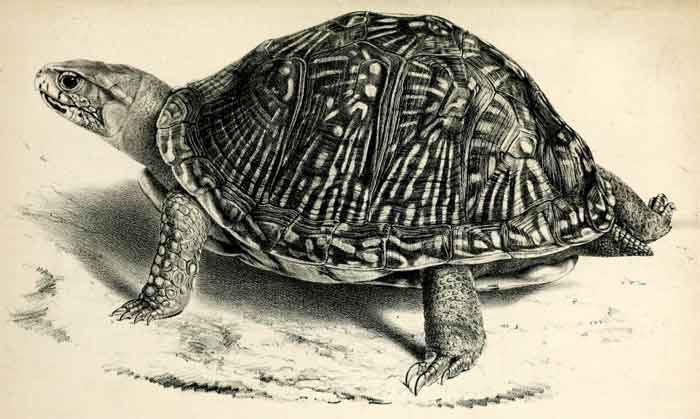
Superregnum: Eukaryota
Cladus: Unikonta
Cladus: Opisthokonta
Cladus: Holozoa
Regnum: Animalia
Subregnum: Eumetazoa
Cladus: Bilateria
Cladus: Nephrozoa
Superphylum: Deuterostomia
Phylum: Chordata
Subphylum: Vertebrata
Infraphylum: Gnathostomata
Megaclassis: Osteichthyes
Cladus: Sarcopterygii
Cladus: Rhipidistia
Cladus: Tetrapodomorpha
Cladus: Eotetrapodiformes
Cladus: Elpistostegalia
Superclassis: Tetrapoda
Cladus: Reptiliomorpha
Cladus: Amniota
Classis: Reptilia
Cladus: Eureptilia
Cladus: Romeriida
Subclassis: Diapsida
Cladus: Sauria
Cladus: Archelosauria
Division: Pan-Testudines
Division: Testudinata
Ordo: Testudines
Subordo: Cryptodira
Superfamilia: Testudinoidea
Familia: Emydidae
Subfamilia: Emydinae
Genus: Terrapene
Species: Terrapene mexicana
Name
Terrapene mexicana (Gray, 1849)
Syntypes: BMNH 1947.3.5.48 (formerly 48.7.28.29-30) and 1947.3.4.4.
Type locality: “Mexico”.
References
Primary references
Gray, J.E. 1849. Description of a new species of Box Tortoise from Mexico. Proc. Zool. Soc. London 1849: 16–17.
Vernacular names
English: Mexican Box Turtle
The Mexican box turtle (Terrapene mexicana) is a species of box turtle belonging to the family Emydidae. It is sometimes treated as a subspecies of Terrapene carolina (Terrapene carolina mexicana).[3]
Geographic range
This species is endemic to Mexico. It is found in the Mexican states of Tamaulipas, Veracruz and San Luis Potosí.[2][5]
Habitat
It lives in areas with tropical climates within humid forests at shallow rainwater puddles.[6]
Description
Terrapene mexicana can reach a length of about 18–20 cm (7.1–7.9 in).[6] The carapace is long and dome-shaped, with rather variable color and markings. The adult males show gray-blue nuances on the head and red or orange nuances on the front legs.[6]
Biology
The Mexican box turtle does not have much information on them because very few of them are domesticated (kept as pets). However, we do know that they have a lifespan of 100 years. Usually these turtles have water nearby homes and a bush to hide. Having a home by the water will attract insects, which are a big part of their diet.
Bibliography
Rhodin, Anders G.J.; van Dijk, Peter Paul; Inverson, John B.; Shaffer, H. Bradley; Roger, Bour (2011-12-31). "Turtles of the world, 2011 update: Annotated checklist of taxonomy, synonymy, distribution and conservation status". Chelonian Research Monographs. 5.
Fritz, Uwe; Havaš, Peter (2007). "Checklist of Chelonians of the World". Vertebrate Zoology. 57
Dodd, C. Kenneth. North American Box Turtles a Natural History. University of Oklahoma Press, 2002.
Milstead, William W., and Donald W. Tinkle. "Terrapene of Western Mexico, with Comments on the Species Groups in the Genus". Copeia, vol. 1967, no. 1, 1967, p. 180., doi:10.2307/1442193
Stone, Lynn M. Nature Watch: Box Turtles. Lynn M. Stone, 2007.
References
Wikispecies has information related to Mexican box turtle.
"Appendices | CITES". cites.org. Retrieved 2022-01-14.
Rhodin, Anders G.J.; van Dijk, Peter Paul; Inverson, John B.; Shaffer, H. Bradley; Roger, Bour (2011-12-31). Turtles of the world, 2011 update: Annotated checklist of taxonomy, synonymy, distribution and conservation status Chelonian Research Monographs. N. 5
Fritz, Uwe; Havaš, Peter (2007). "Checklist of Chelonians of the World"
The Reptile Database
iNaturalist
Herpetomania(in Italian)
Retrieved from "http://en.wikipedia.org/"
All text is available under the terms of the GNU Free Documentation License

